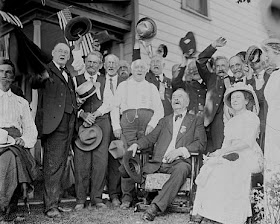[I'd intended to post this information about reunion and memorial quilts today even before I'd read the statement about the missing eagle in a similar quilt discussed in my last post. The flag quilt in that January 22nd post might better be interpreted as one of these veteran's quilts rather than as a message about racial equality.]
One occasionally comes across an antique quilt with Civil War Reunion images.
They are often crazy quilts, popular in the 1880-1910 period when reunions of the Union Army and the Confederate Army were annual events.
Commemorative ribbons were passed out at the encampments. A crazy quilt is a good place to preserve the printed silk souvenir.
Florida Reunion of Confederate Veterans
Quilts with veteran's group connections were made for other reasons too.
The San Jose Mueum of Quilts and Textiles
owns this wonderful 1892 example made by the
Ladies of the G.A.R. in San Jose, California.
The GAR was the name for the largest Union veterans' group---Grand Army of the Republic.
This one was made as a gift for Hattie Burgess Shattuck
by the Ladies of the Grand Army of the Republic,
Anna Ella Carroll Circle No. 1, San Jose, California
See more about it by clicking here
http://www.cqmagonline.com/vol09iss2/articles/994/index.shtml
About 1910
Very often the Ladies Auxiliary was present at the events.
Notice everyone is wearing a ribbon with a medal, even the child on the right,
although no one is wearing a uniform.
(Those old uniforms probably didn't fit at this point anyway.)
Mid 1890s
This block in a crazy quilt seems to recall an 1893
Blue and Gray reunion with soldiers from both sides.
The embroidery says:
Reunion
Confederate
Survivors
Greenwood (?) S.C.
July 4th
1893.?
It looks like someone embroidered over a printed silk ribbon, which eventually wore away.
Here's a detail of a wool embroidered comforter dated 1910 with the letters G.A.R. The photo is black and white. The piece seems to have uniform buttons stitched to it and it may be cut from scraps of an old Union uniform. (I'm always doubtful about supposed uniform scraps but this memorial quilt actually might have some.) This coverlet seems to have been a memorial to an individual veteran.
See more about wool tied quilts from the early 20th century by clicking on this post:
Here's a link to another crazy quilt with reunion ribbons:
Here's a short glossary to initials:
GAR- Grand Army of the Republic (the largest Union veteran's group)
WRC- Women's arm of the G.A.R., the Women's Relief Corps
UDC - United Daughters of the Confederacy)
CSA - Confederate States of America
UCV - United Confederate Veterans
Collecting Civil War reunion ribbons is a nice textile focus.
They are usually silk and need some TLC to survive.




















































